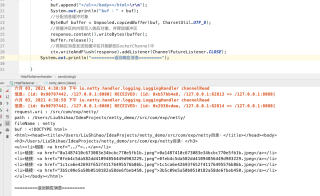Netty的HTTP文件服务器无法返回响应消息

按照《Netty权威指南》书中的内容 HTTP文件服务器,服务端已经接收到了消息,也将响应消息写入到缓存并冲刷,但是页面却显示没有什么响应。不知道为什么?
把上面的代码发出来看看,上面应该要绑定一个网络输出流。
package com.lsh.netty.http;
import io.netty.buffer.ByteBuf;
import io.netty.buffer.Unpooled;
import io.netty.channel.*;
import io.netty.handler.codec.http.*;
import io.netty.handler.stream.ChunkedFile;
import io.netty.util.CharsetUtil;
import javax.activation.MimetypesFileTypeMap;
import java.io.File;
import java.io.FileNotFoundException;
import java.io.RandomAccessFile;
import java.io.UnsupportedEncodingException;
import java.net.URLDecoder;
import java.util.regex.Pattern;
/**
* @author :LiuShihao
* @date :Created in 2021/6/2 11:55 上午
* @desc :HttpFile文件服务器处理类
*/
public class HttpFileServerHandler extends SimpleChannelInboundHandler<FullHttpRequest> {
private final String url ;
public HttpFileServerHandler(String url) {
this.url = url;
}
//当服务器接收到消息时,会自动触发 messageReceived方法
@Override
protected void messageReceived(ChannelHandlerContext ctx, FullHttpRequest request) throws Exception {
try {
// 5.0.0 request.getDecoderRequest() 已经被弃用
//对HTTP请求消息的解码结果进行判断,如果解码失败则返回400错误
if (!request.decoderResult().isSuccess()) {
System.out.println("解码失败返回400");
sendError(ctx, HttpResponseStatus.BAD_REQUEST);
return;
}
//对请求方法进行判断,如果不是从浏览器或者表单设置为GET发起的请求(例如POST),则返回405错误
if (request.method() != HttpMethod.GET) {
sendError(ctx, HttpResponseStatus.METHOD_NOT_ALLOWED);
System.out.println("请求方式不是GET,返回405");
return;
}
//如果URI不合法 返回403错误
final String uri = request.uri();
System.out.println("request.uri : " + uri);
final String path = sanitizeUri(uri);
System.out.println("path : " + path);
if (path == null) {
sendError(ctx, HttpResponseStatus.FORBIDDEN);
System.out.println("URI不合法 返回403错误");
return;
}
//如果文件不存在或者是系统隐藏文件 则返回404错误
File file = new File(path);
if (file.isHidden() || !file.exists()) {
sendError(ctx, HttpResponseStatus.NOT_FOUND);
System.out.println("文件不存在或者是系统隐藏文件 则返回404错误");
return;
}
System.out.println("fileName : " + file.getName());
if (file.isDirectory()) {
if (uri.endsWith("/")) {
sendListing(ctx, file);
} else {
sendRedirect(ctx, uri + "/");
}
return;
}
//判断文件合法性
if (!file.isFile()) {
sendError(ctx, HttpResponseStatus.FORBIDDEN);
return;
}
RandomAccessFile randomAccessFile = null;
try {
//以只读方式打开文件
randomAccessFile = new RandomAccessFile(file, "r");
} catch (FileNotFoundException e) {
sendError(ctx, HttpResponseStatus.NOT_FOUND);
return;
}
//获取文件的长度构造成功的HTTP应答消息
long fileLength = randomAccessFile.length();
// DefaultHttpResponse response = new DefaultHttpResponse(HttpVersion.HTTP_1_1, HttpResponseStatus.OK);
HttpResponse response = new DefaultHttpResponse(HttpVersion.HTTP_1_1, HttpResponseStatus.OK);
HttpHeaderUtil.setContentLength(response, fileLength);
setContentTypeHeader(response, file);
//判断是否是keepAlive,如果是就在响应头中设置CONNECTION为keepAlive
if (HttpHeaderUtil.isKeepAlive(request)) {
response.headers().set(HttpHeaderNames.CONNECTION, HttpHeaderValues.KEEP_ALIVE);
}
ctx.write(response);
ChannelFuture sendFileFuture;
//通过Netty的ChunkedFile对象直接将文件写入到发送缓冲区中
sendFileFuture = ctx.write(new ChunkedFile(randomAccessFile, 0, fileLength, 8192), ctx.newProgressivePromise());
//为sendFileFuture添加监听器,如果发送完成打印发送完成的日志
sendFileFuture.addListener(new ChannelProgressiveFutureListener() {
@Override
public void operationComplete(ChannelProgressiveFuture channelProgressiveFuture) throws Exception {
System.out.println("Transfer complete.");
}
@Override
public void operationProgressed(ChannelProgressiveFuture channelProgressiveFuture, long progress, long total) throws Exception {
if (total < 0) {
System.err.println("Transfer progress: " + progress);
} else {
System.err.println("Transfer progress: " + progress + "/" + total);
}
}
});
//如果使用chunked编码,最后需要发送一个编码结束的空消息体,将LastHttpContent.EMPTY_LAST_CONTENT发送到缓冲区中,
//来标示所有的消息体已经发送完成,同时调用flush方法将发送缓冲区中的消息刷新到SocketChannel中发送
ChannelFuture lastContentFuture = ctx.
writeAndFlush(LastHttpContent.EMPTY_LAST_CONTENT);
//如果是非keepAlive的,最后一包消息发送完成后,服务端要主动断开连接
if (!HttpHeaderUtil.isKeepAlive(request)) {
lastContentFuture.addListener(ChannelFutureListener.CLOSE);
}
}catch (Throwable e){
System.out.println(e.getMessage());
e.printStackTrace();
}
}
@Override
public void exceptionCaught(ChannelHandlerContext ctx,Throwable cause){
cause.printStackTrace();
if(ctx.channel().isActive()){
sendError(ctx,HttpResponseStatus.INTERNAL_SERVER_ERROR);
}
}
private static final Pattern INSECURE_URI=Pattern.compile(".*[<>&\"].*");
/**
*
*
* @param uri
* @return
*/
private String sanitizeUri(String uri){
//对URL进行解码 解码成功后对URI进行合法性判断 如果URI与允许访问的URI一直或者是其子目录(文件),则检验通过否则返回空
try {
uri = URLDecoder.decode(uri,"UTF-8");
}catch (UnsupportedEncodingException e){
try {
uri = URLDecoder.decode(uri,"ISO-8859-1");
}catch (UnsupportedEncodingException e1){
throw new Error();
}
}
//解码成功后对uri进行合法性判断,避免访问无权限的目录
if(!uri.startsWith(url)){
return null;
}
if(!uri.startsWith("/")){
return null;
}
//将硬编码的文件路径分隔符替换为本地操作系统的文件路径分割符
uri = uri.replace('/',File.separatorChar);
//对新的URI做二次合法性校验,如果校验失败则直接返回空
if (uri.contains(File.separator+'.')
|| uri.contains('.'+File.separator) || uri.startsWith(".")
|| uri.endsWith(".") || INSECURE_URI.matcher(uri).matches()){
return null;
}
//最后对文件进行拼接,使用当前运行程序所在的工作目录 + URI 构造绝对路径返回
return System.getProperty("user.dir") + File.separator + uri;
}
private static final Pattern ALLOWED_FILE_NAME = Pattern.compile("[A-Za-z0-9][-_A-Za-z0-9\\.]*");
/**
* 发送目录的链接到客户端浏览器
* @param ctx
* @param dir
*/
private static void sendListing(ChannelHandlerContext ctx,File dir){
//创建成功的http响应消息
FullHttpResponse response = new DefaultFullHttpResponse(HttpVersion.HTTP_1_1, HttpResponseStatus.OK);
//设置消息头的类型是html文件,不要设置为text/plain,客户端会当做文本解析
response.headers().set(HttpHeaderNames.CONTENT_TYPE, "text/html;charset=UTF-8");
//构造返回的html页面内容
StringBuilder buf = new StringBuilder();
String dirPath = dir.getPath();
buf.append("<!DOCTYPE html>\r\n");
buf.append("<html><head><title>");
buf.append(dirPath);
buf.append("目录:");
buf.append("</title></head><body>\r\n");
buf.append("<h3>");
buf.append(dirPath).append("目录:");
buf.append("</h3>\r\n");
buf.append("<ul>");
buf.append("<li>链接:<a href=\"../\">..</a></li>\r\n");
for (File f : dir.listFiles()) {
if (f.isHidden() || !f.canRead()) {
continue;
}
String name = f.getName();
if (!ALLOWED_FILE_NAME.matcher(name).matches()) {
continue;
}
buf.append("<li>链接:<a href=\"");
buf.append(name);
buf.append("\">");
buf.append(name);
buf.append("</a></li>\r\n");
}
buf.append("</ul></body></html>\r\n");
System.out.println("buf :" + buf);
//分配消息缓冲对象
ByteBuf buffer = Unpooled.copiedBuffer(buf, CharsetUtil.UTF_8);
//将缓冲区的内容写入响应对象,并释放缓冲区
response.content().writeBytes(buffer);
buffer.release();
//将响应消息发送到缓冲区并刷新到SocketChannel中
ctx.writeAndFlush(response).addListener(ChannelFutureListener.CLOSE);
System.out.println("=========返回响应消息=========");
}
private static void sendRedirect(ChannelHandlerContext ctx,String newUri){
FullHttpResponse response=new DefaultFullHttpResponse(HttpVersion.HTTP_1_1, HttpResponseStatus.FOUND);
response.headers().set(HttpHeaderNames.LOCATION,newUri);
ctx.writeAndFlush(response).addListener(ChannelFutureListener.CLOSE);
}
private static void sendError(ChannelHandlerContext ctx, HttpResponseStatus status){
FullHttpResponse response=new DefaultFullHttpResponse(HttpVersion.HTTP_1_1,status,
Unpooled.copiedBuffer("Failure: "+status.toString()+"\r\n",CharsetUtil.UTF_8));
response.headers().set(HttpHeaderNames.CONTENT_TYPE,"text/html;charset=UTF-8");
ctx.writeAndFlush(response).addListener(ChannelFutureListener.CLOSE);
}
private static void setContentTypeHeader(HttpResponse response,File file){
MimetypesFileTypeMap mimetypesTypeMap=new MimetypesFileTypeMap();
response.headers().set(HttpHeaderNames.CONTENT_TYPE,mimetypesTypeMap.getContentType(file.getPath()));
}
}
package com.lsh.netty.http;
import io.netty.bootstrap.ServerBootstrap;
import io.netty.channel.ChannelFuture;
import io.netty.channel.ChannelInitializer;
import io.netty.channel.nio.NioEventLoopGroup;
import io.netty.channel.socket.SocketChannel;
import io.netty.channel.socket.nio.NioServerSocketChannel;
import io.netty.handler.codec.http.HttpObjectAggregator;
import io.netty.handler.codec.http.HttpRequestDecoder;
import io.netty.handler.codec.http.HttpResponseDecoder;
import io.netty.handler.logging.LogLevel;
import io.netty.handler.logging.LoggingHandler;
import io.netty.handler.stream.ChunkedWriteHandler;
/**
* @author :LiuShihao
* @date :Created in 2021/6/2 9:10 上午
* @desc :HTTP 服务端开发
*/
public class HttpFileServer {
private String ipAddress = "127.0.0.1";
private static final String DEFAULT_URL = "/src/com/exp/netty/";
public void run(final int port,final String url) throws Exception{
NioEventLoopGroup bossGroup = new NioEventLoopGroup();
NioEventLoopGroup workerGroup = new NioEventLoopGroup();
try {
ServerBootstrap b = new ServerBootstrap();
b.group(bossGroup,workerGroup)
.channel(NioServerSocketChannel.class)
.handler(new LoggingHandler(LogLevel.INFO))
.childHandler(new ChannelInitializer<SocketChannel>() {
@Override
protected void initChannel(SocketChannel ch) throws Exception {
//想ChannelPipeline中添加HTTP请求消息解码器
ch.pipeline().addLast("http-decoder",new HttpRequestDecoder());
//添加HttpObjectAggregator解码器,作用是将多个消息转换为单一的FullHttpRequest或者FullHttpResponse,
// 原因是HTTP解码器在每个HTTP消息中会生成多个消息对象。
ch.pipeline().addLast("http-aggregator",new HttpObjectAggregator(65536));
//增加HTTP响应编码器,对HTTP响应消息进行编码
ch.pipeline().addLast("http-encoder", new HttpResponseDecoder());
//添加Chunked handler 作用是支持异步发送大的码流(例如文件传输),但不占用过多的内存,防止发生Java内存溢出错误
ch.pipeline().addLast("http-chunked",new ChunkedWriteHandler());
//最后添加HTTPFileServerHandler 用于文件服务器的业务逻辑处理
ch.pipeline().addLast("fileServerHandler",new HttpFileServerHandler(url));
}
});
ChannelFuture future = b.bind(ipAddress, port).sync();
System.out.println("HTTP 文 件 目 录 服 务 器 启 动 ,网 址 是 :http://"+ipAddress+":"+port+url);
future.channel().closeFuture().sync();
}catch (Exception e){
System.out.println(e.getMessage());
}finally {
bossGroup.shutdownGracefully();
workerGroup.shutdownGracefully();
}
}
public static void main(String[] args) throws Exception {
int port = 8080;
String url = DEFAULT_URL;
new HttpFileServer().run(port,url);
}
}